 |

 |
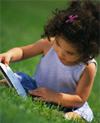 |

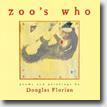



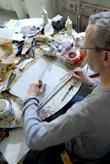
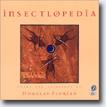
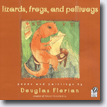 |
Children's picture & poetry book author/illustrator Douglas Florian's
books include zoo's who, Insectlopedia, Beast Feast and more |
Interviewer Luan Gaines: You combine your skills
as an artist and a writer in your series of rhyming
children's books. Which came first, or is that like asking
about the chicken and the egg?
Douglas Florian: My dad is an artist and I grew up in
a house surrounded with paintings, drawings, sculptures and
reliefs, and to my relief never stopped loving it.
Writing for children is not as easy as it appears. Can
you speak to the process involved when writing for the
children's market?
It took me about ten years before I found poetry as my
niche. While at Greenwillow Books I told my editor Libby
Shub that I wanted to illustrate the poems of Jack Prelutsky,
also at Greenwillow. She told me there was a long line of
illustrators ahead of me. So, I had to write my own poetry.
Of course that came years later.
How long have you been writing and publishing children's
books?
I have been illustrating (not publishing) children's books
since 1977 when I created the pictures for Dorothy O. Van
Woerkom's Tit for Tat. I wrote and illustrated my first
book, A Bird Can Fly, in 1980.
I may be misinformed, but don't children's book
publishers use one illustrator and another writer, rather
than one person doing both? If so, how did you persuade your
publishers to accept the total package?
Publishers do whatever works. Some people only write, some
only illustrate, and some do both. A good editor makes a
book live up to its full potential.
Your titles concentrate on nature, animals and insects.
How do you choose the subjects for each of your
unconventional books?
The subjects choose me. Whatever tickles my fancy or bangs
my funny bone I approach with vim and vigor, or vice versa.
Tell me about a day in the life of a children's book
author when a new project is in the works.
I always wake up at noon. Just kidding. Actually every day
is a little bit different, just as I want every book to be
at least a little bit different. I try to avoid formula,
although we are all creatures and teachers of habit. I will
say that almost always the poems come first, the pictures
come second, and going fishing comes a distant third. I
don't like to do sketches or a dummy, as I want the finished
art to be spontaneous. I do much research on my subjects,
then forget it so I have freedom to do something unique. I
don't like working too closely to photographs, as that
cramps my playfulness, messiness, silliness, and finesse.
Your love of language is obvious. How do you use words to
incite the curiosity of youngsters who read your books?
In poetry you can pull or push words, s t r e t c h words,
shape words, invert words, invent words, use bad grammar,
bad spellllling, or anything that makes the poem better.
That's poetic license, and I get mine renewed every
Thursday.
My granddaughter's vocabulary has expanded since reading
your books. How do you structure the challenges, while
keeping the words within the reach of young readers?
I don't expect children to understand 100% of my books by
themselves, just as we don't understand 100% of reality.
When I was very young my dad would bring home the New Yorker
magazine once a week, and I would always look at the
cartoons. I only understood maybe 25%, but that didn't stop
me from enjoying them.
Do you believe that rhyming and alliteration help advance
children's reading? If so, why?
Children naturally gravitate to rhyme and alliteration and
have for hundreds, if not thousands, of years. Just go to a
playground and you'll hear them do that.
What are some of your favorite animal or insect
characters featured in the books?
I have so many favorites, but the chihuahua, the porcupine,
the slugs, the ladybugs, and the daddy longlegs stand out.
Of course ladybugs and daddy longlegs have more legs to
stand out with.
Do you think children's writing can be taught? Beyond
technique, isn't a natural creativity involved? Please
explain your views on the creative process.
I think writing can be taught, but I also believe that
potential writers are born. Not every one of those lives up
to his or her potential, so that's where teachers come in.
Most of your books are watercolor and collage. Is this
your medium of choice for illustrations? Does this technique
allow the most expression for your ideas?
Watercolor has a fresh brilliant quality, and also seems
somewhat childlike. Collage is a great way of connecting the
unconnected. There's often an accidental quality to it I
love.
Continuing the question about your art: I just got my
copy of zoo's who and see that you have added some
interesting touches to your excellent art in this new book.
Can you elaborate on the techniques you have incorporated in
this book?
In zoo's who,as it says in the colophon, I used watercolor,
gouache, colored pencils, inks, tin foil, candy wrappers
(the lemons and oranges of The Pig), shredded papers,
stencils, rubber stamps (the typography resembles rubber
stamps), and much collage on primed brown paper bags. All of
these hopefully give an expressive and exploratory feeling
to the art with the intention of connecting disparate
elements.
Since you have five children, I probably don't need to ask
about your constant source of inspiration. Any comments?
I use my kids more as a sounding board than as a direct
source of inspiration. They, along with my wife, provide
feedback prior to publication. If my own kids don't think
something is funny or well done, then I can't expect someone
else's kids to.
Are your children artistic as well?
They are artistic to varying degrees and intensities. So far
my second daughter seems to have caught the creative bug the
most.
Children see the world with eyes and minds wide open. How
important is it to you, as an author/illustrator, to offer
young minds your vision of language and art?
I do try to see the world fresh each day, as a child does.
Sometimes the most mundane things amaze me. Recently,
waiting on line for a bus I chanced to look up and saw in
the sky a hawk pursuing a small bird in a life and death
struggle for five minutes. After the bird escaped harm I
looked down to see that nobody else in the line had noticed,
as most were on their cell phones.
There is great humor in your work, clever twists with words.
How important is humor when you put a book of poems and
illustrations together?
Humor is essential. Even the tragedies of Shakespeare had
humor. Writing light verse is a funny way to earn a living.
In your work so far, do you have a favorite title (mine is
Beast Feast)?
I have three favorites: beast feast, lizards, frogs, and
polliwogs, and the new title, zoo's who.
How frequently do you begin a new title? What length of time
is involved from start to finish?
I do one or two books a year. It usually takes me three or
four months to complete a book.
Since zoo's who, have you started on another project? If so,
can you tell us a little about it?
I've just finished a book on spring for Greenwillow. It's
called Handsprings, and it's the last book in my seasons
series.
What advice would you give to would-be children's book
authors? Would that advice differ (or not) in relation to
children's book artists?
Someone once said, "The harder I work, the luckier I get."
So get down to work, but try to have fun. That is, write or
paint about something that you feel strongly about, or want
to learn about. Albert Einstein said, "Curiosity is a
species of Genius." So BE CURIOUS!!!
What is your favorite thing about your work?
The favorite thing about my work is when I surprise myself,
when I do something that I didn't think I could do.
|






 |
| |
Luan Gaines/2005 for curled
up with a good kid's book |
|
|
For grown-up fiction, nonfiction and speculative fiction book reviews,
visit our sister site Curled Up With a Good Book (www.curledup.com)
|
|